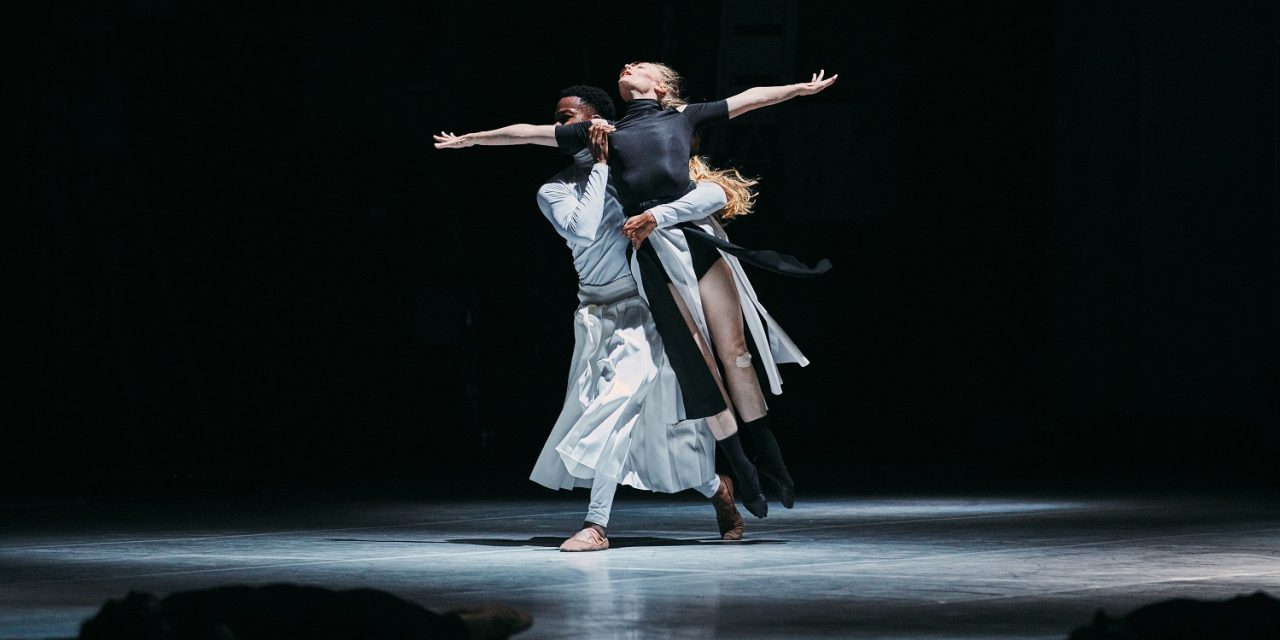The home for L.A. Dance Project (LAPD) is located near the junction of Washington Blvd, and Santa Fe Avenue with easy access from both the 10 and the 5 Freeways. The company was founded by Choreographer and Filmmaker Benjamin Millepied a former principal dancer with New York City Ballet, one-time Director of the Paris Opera Ballet, and for movie goers, the choreographer for the 2010 American psychological horror film Black Swan directed by Darren Aronofsky and starring Natalie Portman.
This past weekend, LAPD presented Millepied’s evening-length work I fall, I flow, I melt at its beautiful 2245 studio space, and of the works that I have seen by Millepied, this appeared to be one in which he was expanding his choreographic ideas and methods. Not all of this new territory worked, but it was wonderful to see Millepied demonstrating a willingness to take risks. And, there were many beautiful moments within that were heightened by the extraordinary talents of his twelve-member cast.
Millepied selected the music of Johann Sebastian Bach for I fall, I flow, I melt, and for two or three sections during the first half we were treated to live music performed superbly by Violist Etienne Gara, Founder, Music and Artistic Director of Delirium Musicum.

Nayomi Van Brunt in “I fall, I flow, I melt” Choreography by Benjamin Millepied – Photo by Jonathan Potter
The piece began with the cast walking processional style into the space along the side and back walls. While lit in silhouette, they moved onto the stage area expanding the ritualistic atmosphere by forming a circle with blond wooden, straight back chairs that they were carrying. This aptly set the mood for the work’s first section performed to sections from Bach’s very familiar St. Matthew Passion.
Three lines of dancers moved separately creating a spiritual celebratory wave that broke off into a frenzy of movements and tableaux that resembled religious paintings or tapestries often seen in many Catholic cathedrals. Here, Millepied’s sweeping lyrical movements reminded me of early works created by choreographer Mark Morris. The beauty of the movement was somewhat dimmed, however, by Millepied’s choice not to open up the circle, limiting the space in which the dancers had to fully execute his wonderfully large and fast movement phrases.

(L to R) Rachelle Rafailedes and Daisy Jacobson in “I fall, I flow, I melt” Choreography by Benjamin Millepied – Photo by Daniel Beres
Gara performed live for the next four movements which included a wonderful solo performed by Mario Gonzalez; a solo that developed into a duet with the amazing Rachelle Rafailedes that was soon joined by the wonderfully mysterious Janie Taylor. A lively duet with Gianna Reisen on pointe who, after a brief duet with Rafailedes and Nayomi Van Brunt, joined the other female cast still wearing her pointe shoes. Why? A single dancer wearing pointe shoes in this group was distracting. These were followed by a solo performed with great spirit by Shu Kinouchi, who claimed total ownership of the movement. He was followed by another solo performed powerfully by Gonzalez and the two men then combined their talents in a very athletic and high spirited duet.
The final section before intermission was, for the most part, filled with movement that was so fast it impeded the dancers’ abilities to complete it fully. This frenzy soon took on the look of organized chaos and in the very few moments of stillness they did not seem to breathe, but instead to hold their breath.
The choreography in the second half of the program was more lyrical, but also sometimes too fast for the dancers to finish a movement phrase before dashing off to the next. Here, I did not find the choreography musical, although there was a step for every musical note. Millepied either does not understand or he has chosen to ignore the multi-layers of Bach’s gorgeous and inspiring music; choosing instead to primarily follow the melody.
There was one solo that did flow, the phrases were completed and connected therefore allowing one to see the musicality. The dancer was Rachelle Rafailedes performing in total silence except for a wonderful moment when there was the sound of a jet airline flying past overhead.
The work ended with the dancers costumed in medieval style dresses; some solid white, some all black and a few both black and white. Here Millepied brought us back into the pseudo-religious realm with Bach’s Passacaglia in C minor for Organ. There were many gorgeous brief solos, duets and quartets, but I felt that the dance had two endings; the first being the strongest. After dancers flew through the air to be caught cradle-like a la Paul Taylor’s Esplanade, they gathered inside a center spotlight to create a human funeral pyre. I fall, I flow, I melt was, however, one of Millepied’s best works.
The lighting by Roderick Murray as adapted by Francois-Pierre Couture several times left dancers in darkness by blinding the audience or in one case turning beautiful black and white costumes a muddy gray by flooding the space with amber light.
The costumes were by Alessandro Sartori for Ermenegildo Zegna Couture. The most beautiful and appropriate were the white shorts and halter tops worn by Rafailedes and Van Brunt during the first half of the work. Although the black and white costumes looked beautiful on the dancers while standing still, several of them restricted the dancers’ movements.
The extraordinarily talented cast of I fall, I flow, I melt included Doug Baum, Lorrin Brubaker, Anthony Lee Bryant, David Adrian Freeland, Jr., Mario Gonzalez, Daisy Jacobson, Shu Kinouchi, Rachelle Rafailedes Gianna Reisen, Vinicius Silva, Janie Taylor, and Nayomi Van Brunt. Each and everyone of them had their moments of standing out.
Written by Jeff Slayton for LA Dance Chronicle, February 2020.
To visit the L.A. Dance Project website, click here.
Featured image: David Adrian Freeland, Jr. and Janie Taylor in I fall, I flow, I melt Choreography by Benjamin Millepied – Photo by Daniel Beres









